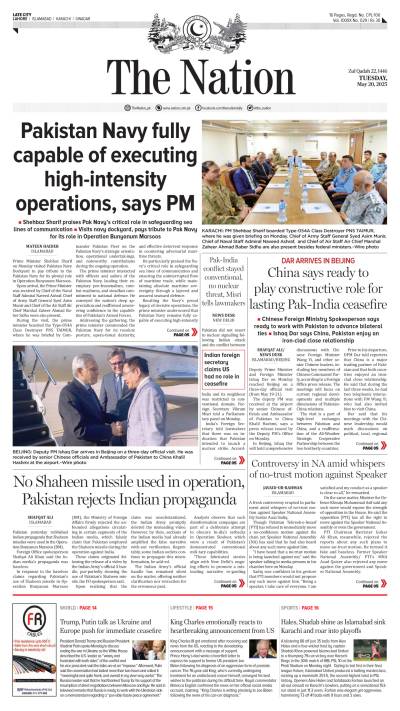Pool of skilled workforce being expanded: NAVTTC
ISLAMABAD (APP): National Vocational & Technical Training Commission (NAVTTC) has utilized an amount of Rs7417.142 million during last four years under Prime Minister's Youth Skill Development Programme (PMYP) which was launched to expand pool of skilled workforce. Of the total allocation of Rs. 10748.425 during last five years, the Commission had utilized an amount of Rs780.322 million in first phase of PMYSDP during year 2013-14 & 2014-15 while an amount of Rs921.281 million was utilized in second phase of the programme during year 2014-15 & 2015-16. Similarly, an amount of Rs2614.539 was utilized in the on-going third phase of the programme (2015-18) while an amount of Rs3101 was utilized in fourth phase of the programme during year 2017-18. The programme was allocated an amount of Rs. 800 million during 2013-14 & 2014-15 (phase-1), Rs. 1122.425 million 2014-15 & 2015-16 (phase-2), Rs. 2630 million 2015-18 (phase-3), Rs. 3101 million 2017-18 (phase-4) and Rs. 3095 million for year 2018-19 (phase-4).
When contacted official sources said undoubtedly, Human Resource Development (HRD) plays a central role in economic growth of any country and added NAVTTC well cognizant of this fact has taken numerous steps for development of Human Resource through provision of technical hands-on skills,enabling a large number of unskilled & unemployed youth to earn their bread & butter through fair means of livelihood.
The sources said since inception, NAVTTC has primarily focused to expand pool of skilled workforce to bridge gap between demand and supply for skilled manpower within and outside Pakistan.
NAVTTC primarily focused human resource development related to local job market. National Mega projects like China Pakistan Economic Corridor (CPEC) and other energy related projects through skill development are expected to generate around two million jobs for skilled human resource.
NAVTTC is utilizing all its efforts to generate competent manpower in construction sector, hospitality, manufacturing in large medium and small industry, domestic manufacturing, business & Information Technology and even paramedics.
The sources said to ensure the even participation of females in job market, NAVTTC has reserved a minimum of 30 per cent quota for enrollment of females in skill development programmes and a full-fledged sector related to female specific skills is incorporated which caters the vocations like beautician, dress making & fashion designing and fine arts.
The prime focus is to enroll less educated and unskilled youth of the country to convert them into valuable human resource. Three phases of the programme alongwith one batch (out of two) of phase-IV have been successfully completed, targeting provision of hands-on skills in marketable trades to 200,000 youth.
Apart from catering to quantitative needs of human resource development, NAVTTC is also striving to improve quality of skilled workforce in line with international standards of job market through its other components like Competency Based Trainings, Accreditation & Certification, Piloting of Apprenticeship Reforms, Job placement & Career Counseling, National Vocational Qualification Framework (RPL & RCC) and strengthening Public Private Partnership to bridge demand & supply gap.
The sources said NAVTTC has a strong coordination/liaison with provincial governments, Chambers of Commerce & Industries etc. All the provincial stakeholders (Public & Private) are taken on-board at planning and execution stage of the project to cater geographic skill demands.
The sectors other than construction, being focused for human resource development are agriculture, health/paramedics, business & IT, hospitality & tourism, media related trades and fashion & beauty.
The manufacturing industry includes: Textile (home textile fabrics, garments, knitwear & hosiery), sports goods & wears, leather goods, glass ceramics & pottery and surgical instruments manufacturing.
Zigzag tech in kilns to cut cost
MULTAN (APP): International experts Sunday stressed kiln owners to adopt new zigzag technology as is not only environment-friendly but also cost-effective. Zigzag brick-kiln technology reduces 40 per cent coal consumption for baking of bricks and similarly, it also offers 90 per cent top quality bricks compared with 70 per cent secured through conventional methods, said international experts from Nepal Resma Dixit, Raj Kumar, Syuas Prajapots and Syama Maharjan. They were speaking at a workshop, held on environmental issues and modern brick-kilns technology. The workshop was jointly organised by Environment Protection Department Punjab, International Centre for Integrated Mountain Development (ICIMOD), National Energy Efficiency and Conservation Authority (NEECA) and Pakistan Brick-Kiln Association at a local hotel. The experts said that the world was adopting zigzag technology in kilns, as the centres are a major source of rising pollution in the country.
They said that the new technology was cheap as it reduces over 40pc coal consumption and provides over 90pc top quality bricks.
In Pakistan, there are over 20,000 kilns and these were causing huge pollution.
Nepali expert Resma Dixit told APP that baking of 1,000 bricks used to add 2-kg of smoke to the atmosphere in traditional style brick-kilns, while it could be reduced to 400 grams only by adopting the zigzag technology.
Technical Manager Asad Mehmood said that the NEECA was working on efficient use of energy and coal is important sources for producing energy in the country. Coal is used in brick-kiln industry so the NEECA was facilitating the Environment Proyection Department to check rising pollution in the atmosphere.
Country Representative ICIMOD Abdul Wahid Jasra said that the international body was working in eight countries including Pakistan, Bangladesh, India, Bhutan, Nepal, Burma, Afghanistan and China. The mandate of ICIMOD was to work in mountainous areas of the the countries.
President Brick-Kiln Association Pakistan Shoaib Niazi also observed that their organisation would surely follow zigzag technology.
Muhammad Ikraam, a kiln owner, who recently installed zigzag technology as pilot project in Raiwind, stated that the technology was very much effective in terms of cost as well as reduction in pollution.
Exports of transport services rise 6pc
ISLAMABAD (APP): The transport services by Pakistan in other countries increased by 5.74 percent during the financial year 2017-18 compared to last year, PBS reported. Pakistan exported transport services worth $977.470 million in July-June (2017-18) against the exports of worth $924.371 million in July-May (2016-17), showing 5.74 percent growth, according to data of PBS. Among these, the air transport services export increased by 7 percent and reached to $898.590 million during the period under review against $839.790 million last year. Among the air transport services, exports of passenger services surged by 13.51 percent, from $479.720 million to $544.540 million, the data revealed while the freight service exports witnessed increase of 3.33 percent by going up from $19.510 million to $20.160 million. However, the other air transport services declined by 1.96 percent by slipping from exports of $340.560 million last year to $333.890 million in 2017-18. On the other hand, the exports of sea transport services slipped by 48.56 percent by going down from $40.180 million to $20.670 million.
Among sea transport, the freight service export decreased by 27.23 percent from $13.110 million to $9.540 million while the export of other sea transport service decreased by 58.88 percent by slipping from $27.070 million to $11.130 million.
Meanwhile, the services of road and rail transport witnessed increase of 26.44 percent and 1000 percent in exports during the period under review.
The road transport services increased from $42.011 million to $53.120 million whereas the rail transport service increased from $0.010 million to $0.110 million, the PBS data revealed.
It is pertinent to mention here that the overall exports of services from the country witnessed negative growth of 6.29 percent during financial year 2017-18 as compared to the corresponding period of last year.
The services exports during July-June (2017-18) were recorded at $5.205 billion against the exports of $5.554 billion during July-June (2016-17).
The imports of services into the country increased from $9.893 billion last year to $10.376 billion during FY 2017-18, showing positive growth of 4.88 percent.
Based on the figures, the services trade deficit during the fiscal year 2017-18 fiscal year witnessed growth of 19.18 percent by going up from the deficit of $4.338 billion last year to $5.171 billion during FY2017-18.
SKHPP to generate 3,000 jobs for locals
ISLAMABAD (APP): The Suki Kinari Hydropower Project (SKHPP), one of the largest private sector run-of-the-river projects, will generate around 470MW inexpensive electricity to meet ever-growing energy needs of the country and provide 3,000 more job opportunities to locals, mitigating their financial sufferings. "The SKHPP, being executed under CPEC, will become operational in 2022 and generate jobs for 3,000 local residents under recruitment plan in 2019 and 2020," said Counsellor Embassy of China Li Yuanling. The Suki Kinari (SK) hydropower project located on Kunhar River in the Kaghan Valley of District Mansehra, Khyber Pakhtunkwa, will add 870 MW to the national grid by December 2022. He said presently around 1,600 Pakistani people are working on the SKHPP including over 900 skilled manpower and 700 laborers. He said the company is hiring the services of labourers from district Mansehra only. Highlighting the recruitment criteria, he said notice board had been placed at main gate of the project site office to hire services of the locals.
Giving detail of the project, the Counsellor said the SKHPP had been included in the CPEC projects for being in an advanced stage of development.
He said majority of local people have no experience to work in hydropower or other engineering projects, and they need to be trained by Chinese foreman or skilled man such as surveyor, operator for heavy equipment, carpenter, electrician, welder and plumber etc.
He said Chinese company 'China Gezgouba Group Corporation' initiated work on Suki Kinari Hydropower Project in December 2016 and total cost of the project is $1.92 billion and would be completed within 72 months.
He said this is the only hydropower project in Khyber Pakhtunkhwa on the CPEC list and the Project is listed as the high priority 'Early Harvest Project (EHP)' within CPEC projects.
He said this project is being supported and closely monitored by the governments of Pakistan and China due to its importance.
He said Chinese investments in Pakistani infrastructure and power projects will surely lead to a "virtuous cycle", thus making the country more attractive for foreign investment in a variety of sectors.
The project is being built on a "Build-Own-Operate & Transfer" basis in accordance with Government of Pakistan's Policy for Power Generation Projects 2002, he added.
He said that total operational life of the project is 100 years and the company will hand over the Suki Kinari hydropower project to the Government of Pakistan after 30 years.
He said during this period, the company will be responsible for its maintenance and other expenditures. He said National Electric Power Regulatory Authority (NEPRA) will determine the tariff of the project.
He also said that work on oil-based 12 megawatt project is in full swing to provide electricity to site area of the project.
The potential for energy generation from Kunhar River was first identified around 1960. In 1959, Charles T Main US consultants were engaged by WAPDA to study this potential. In January 1960, they issued a report entitled "Kunhar River Project-Kaghan Valley."
Further studies were conducted in 1984 and 1995 to optimize the power potential of Kunhar River. These studies identified a series of potential sites along the river from where the energy could be produced by cascading the water energy through run-of-the-river hydro projects.
Studies suggested potential sites for these projects at Batakundi, Naran, Suki Kinari, Balakot and Patrind. Run-of-the-river project envisages that the water is drawn from the river, taken to the turbines in a powerhouse, located downstream through tunnel and after running the turbines and producing energy, the water is again diverted back to the river.
He said the company had also constructed, Balakot bridge, damaged by the flood in 2017. It took 10 days to complete the construction of the bridge and got appreciation from NHA, local government and local people.





